Physical Address
304 North Cardinal St.
Dorchester Center, MA 02124
Physical Address
304 North Cardinal St.
Dorchester Center, MA 02124
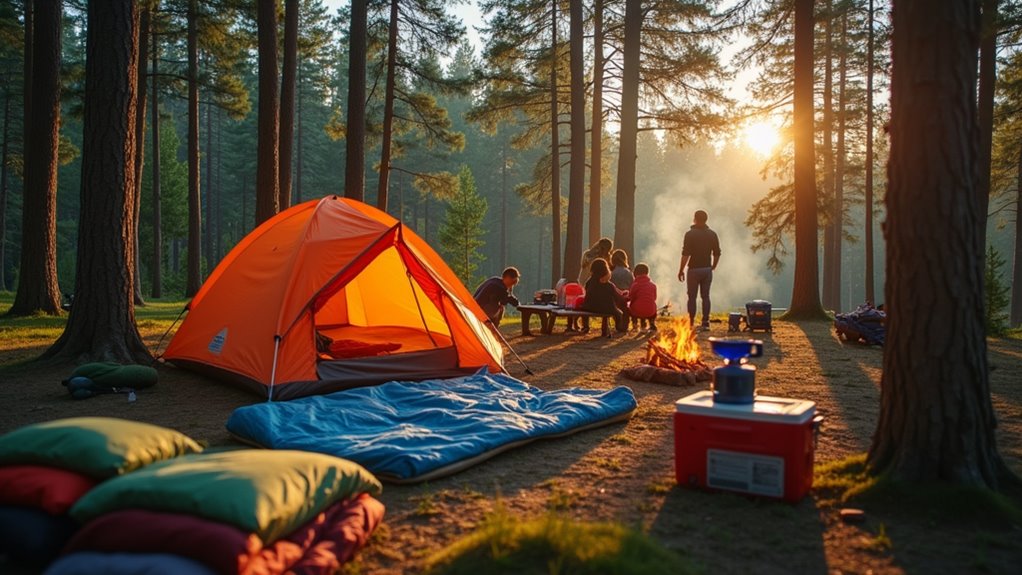
Just discovered the secret camping tips that transform chaotic family trips into unforgettable adventures—number 7 will surprise you.
You’ve probably dreamed of that perfect family camping trip where everyone’s happy, the s’mores turn out just right, and nobody complains about sleeping on the ground. But let’s be honest—without proper planning, your outdoor adventure can quickly turn into a series of preventable mishaps and meltdowns. The difference between camping chaos and camping bliss often comes down to knowing a few key strategies that experienced families swear by.
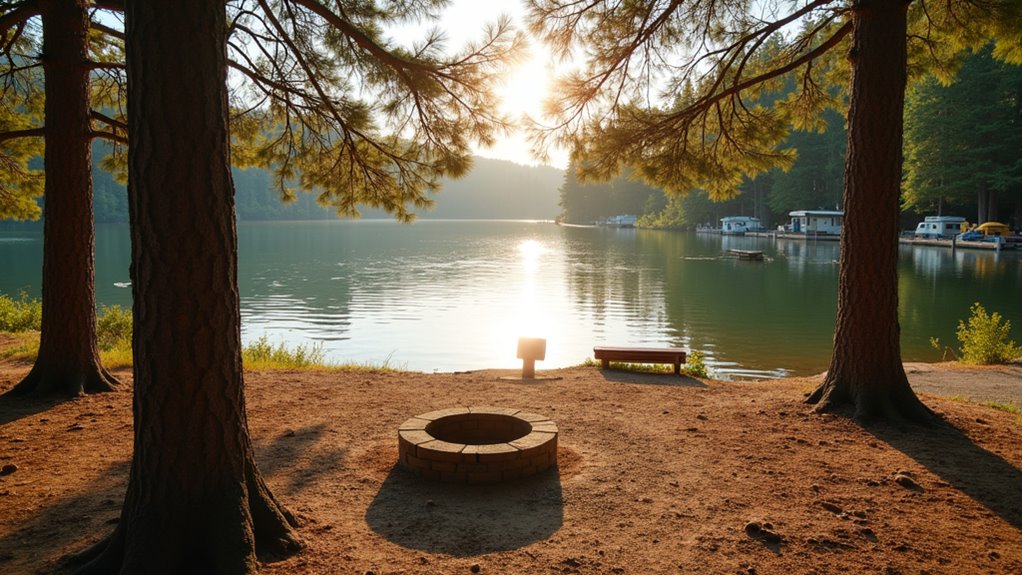
When you’re planning your family’s first camping adventure, selecting the right campsite can make or break the entire experience. You’ll want to prioritize sites with clean restrooms and potable water nearby, especially if you’re camping with young children.
Look for level ground that’s large enough for your tent and gear without being too close to other campers.
Choose a spacious, flat campsite with adequate room for equipment while maintaining comfortable distance from neighboring campers for privacy.
Consider proximity to activities your family enjoys – hiking trails, lakes, or playgrounds.
Sites with some shade are essential for hot days, but avoid camping directly under large trees that might drop branches.
Check if the campground offers amenities like showers, camp stores, or fire rings.
Book early for popular destinations, and always have a backup plan in case your first choice isn’t available.
If you’re bringing your four-legged family member along, ensure the campground allows pets and has adequate space for safe dog camping activities.
Since nothing ruins a camping trip faster than forgotten essentials, creating a thorough packing checklist weeks before your departure will save you stress and guarantee your family’s comfort.
Start with shelter basics: tent, sleeping bags, pillows, and camp chairs.
Don’t forget cooking necessities like a portable stove, matches, cooler, and eating utensils.
Pack weather-appropriate clothing for each family member, including rain gear and extra socks.
Include first aid supplies, flashlights, batteries, and personal hygiene items.
Add entertainment like cards, books, or travel games for downtime.
Check items off as you pack them, and assign age-appropriate packing responsibilities to older kids.
Store your master checklist digitally so you can reuse and refine it for future trips.
Remember that choosing the perfect campsite requires considering multiple factors, so research your destination thoroughly before finalizing your packing list.
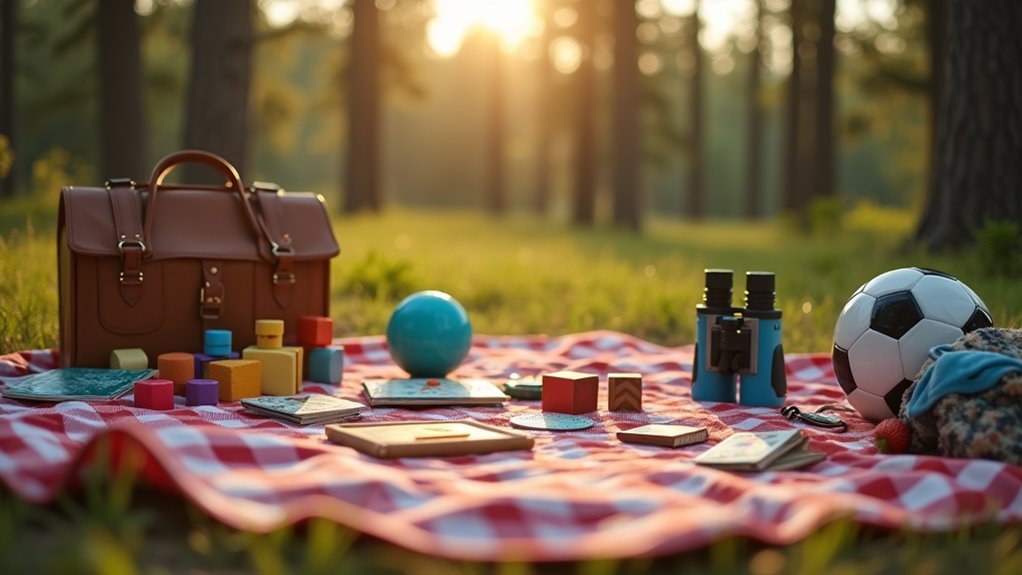
While packing gear keeps your family comfortable, bringing the right entertainment prevents boredom and meltdowns when weather confines everyone to the tent. Pack different activities for various age groups. Toddlers need coloring books, small toys, and simple puzzles.
School-age kids enjoy card games, travel-sized board games, and nature scavenger hunts. Teens might prefer portable chargers for devices, books, or photography challenges.
Don’t forget backup plans for rainy days. Bring storytelling prompts, travel journals, or craft supplies that work in tight spaces. Consider glow sticks for evening fun and flashlight shadow games.
Pack everything in waterproof bags to keep activities dry.
Mix screen-free options with occasional device time. This balance keeps everyone engaged while maintaining camping’s unplugged benefits. Plan activities that work both inside and outside your tent. Practicing tent sleepovers at home before your trip helps kids adjust to the camping environment and reduces anxiety about sleeping outdoors.
After you’ve sorted out entertainment, you’ll need to tackle food planning—another key factor in camping success. Keep meals simple to avoid stress and cleanup hassles. Pre-cut vegetables at home and pack them in sealed containers. Choose one-pot meals like chili, pasta, or stir-fries that require minimal dishes.
Don’t forget easy breakfast options—instant oatmeal, granola bars, or pre-made sandwiches work perfectly.
Pack a cooler strategically with frozen items at the bottom and frequently used items on top. Bring disposable plates and utensils to minimize washing. Pre-make snacks like trail mix or cut fruit to keep kids satisfied between meals.
Consider foil packet meals that cook directly over the fire—they’re fun for kids and create virtually no cleanup. For inspiration, try some of the easiest camping recipes that require minimal preparation and cooking skills.

Though nights in the wilderness can be chilly and uncomfortable, you’ll sleep soundly with the right setup. Start with quality sleeping bags rated for expected temperatures. Add sleeping pads underneath for insulation and cushioning against hard ground. Don’t skimp here—uncomfortable nights ruin camping trips.
Choose your tent location carefully. Pick level ground away from water runoff paths. Clear rocks and sticks before setting up. Inside, create designated sleeping zones for each family member using small pillows or stuff sacks.
Pack familiar comfort items like favorite blankets or stuffed animals for kids. Consider battery-powered fans for hot nights or extra layers for cold ones. Test your sleeping system at home first. You’ll avoid surprises and ensure everyone gets restorative sleep. Remember that having the right camping gear basics forms the foundation of any successful outdoor adventure.
Before you roast your first marshmallow, you’ll need clear safety rules that everyone understands and follows. Start with fire safety—establish boundaries around the campfire and assign an adult to supervise at all times. Teach kids never to run near flames and always extinguish fires completely.
Create a buddy system so no one wanders off alone, especially after dark. Set boundaries for your campsite and surrounding areas. Show everyone where the first aid kit stays and how to use a whistle for emergencies.
Plan your emergency procedures before you need them. Identify the nearest hospital and ensure someone has cell service or knows where to find it. Designate meeting spots if anyone gets separated. Practice these procedures so they become second nature for your family.
Once safety protocols are established, you can focus on organizing camping activities that keep everyone engaged and entertained throughout your trip.
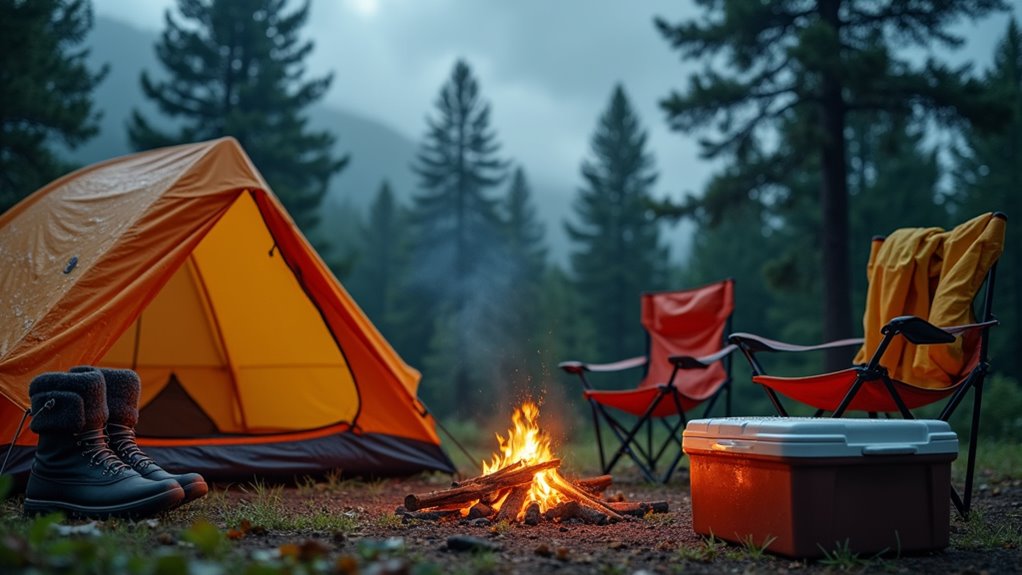
Weather can shift from sunny skies to thunderstorms in minutes, so you’ll want backup plans for every scenario. Pack rain gear for everyone, including waterproof jackets and extra tarps to cover your campsite. Check weather forecasts before departing and monitor conditions throughout your trip using a weather radio or smartphone app.
Prepare indoor activities like card games, books, or tablets for tent-bound hours during storms. Set up your campsite with drainage in mind—avoid low-lying areas where water collects. Keep extra clothing in waterproof bags, especially socks and underwear.
If severe weather threatens, know your evacuation routes and nearby shelters. Teach kids to recognize dangerous weather signs like sudden temperature drops or darkening skies. Always prioritize safety over camping plans. If you’re camping near water, consider whether renting a boat might be a better option than purchasing one for occasional family outings.
Planning your days around unpredictable weather becomes much easier when you build flexibility into your camping schedule from the start. Don’t pack every hour with rigid activities that’ll stress everyone out if plans change. Instead, create loose time blocks for major activities like hiking, swimming, or exploring nearby attractions.
Keep backup indoor activities ready for rainy days—card games, books, or crafts work perfectly. Plan your most important must-do activity for the day with the best weather forecast, then fill remaining time with flexible options.
Build in plenty of downtime for kids to just play and explore around your campsite. You’ll find that some of your family’s best camping memories happen during these unplanned moments when everyone’s relaxed and spontaneous.
When packing for your trip, consider what items to leave at home to avoid unnecessary weight and complications that could disrupt your flexible schedule.
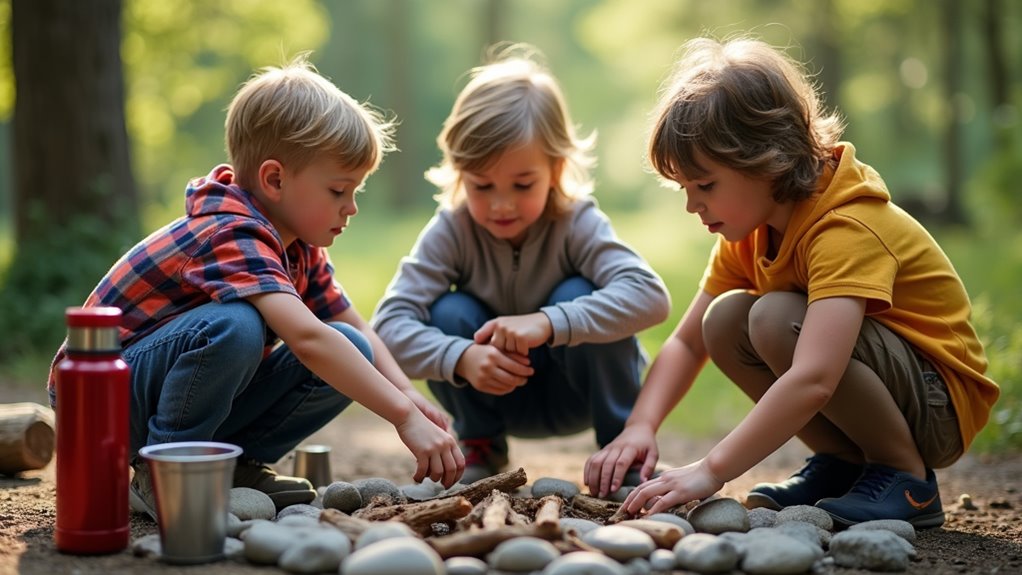
While it might seem easier to handle everything yourself, getting your kids involved in camping tasks transforms them from passive passengers into engaged participants who feel ownership of the experience.
Assign age-appropriate responsibilities that build confidence. Younger children can help gather kindling, sort camping gear, or carry lightweight items.
Older kids can assist with tent setup, meal prep, or map reading during hikes.
Make it rewarding, not burdensome. Turn tasks into games or competitions. Let them choose which responsibilities they want to tackle first. Praise their efforts, even when results aren’t perfect.
When kids contribute meaningfully to camp operations, they develop problem-solving skills and outdoor confidence.
They’ll also complain less about discomforts because they’re invested in making the trip successful rather than just enduring it.
Remember that proper trip preparation with your children beforehand will help them understand their roles and feel more confident about their camping responsibilities.
When you’re miles from the nearest hospital, a well-stocked first aid kit becomes your family’s safety net. Don’t rely on basic bandages alone – pack supplies that address real camping scenarios.
Your kit should handle common outdoor injuries and illnesses:
Include any prescription medications your family takes, plus extras in waterproof containers. Check expiration dates before each trip and replace outdated items immediately.
Consider adding emergency blankets, instant cold packs, and a digital thermometer to handle temperature-related emergencies and provide immediate injury response when accidents occur far from medical facilities.

Family camping trips offer the perfect opportunity to instill lifelong environmental values in your children while preserving nature’s beauty for future generations. Teach kids the seven Leave No Trace principles through hands-on practice. Show them how to pack out all trash, including food scraps and toilet paper. Demonstrate proper campfire safety by using established fire rings and completely extinguishing flames with water, not dirt.
Let children help minimize campsite impact by walking on durable surfaces and avoiding fragile vegetation. Teach them to observe wildlife from a distance and never feed animals. Make it fun by turning cleanup into a game—see who can spot the most litter to collect.
You’re creating responsible outdoor enthusiasts who’ll protect these spaces for their own future families.
Like Dorothy discovering there’s no place like home, you’ll find that home can be anywhere when you’re surrounded by family under the stars. Don’t let perfect be the enemy of good – embrace the chaos, laugh at the mishaps, and remember that s’mores taste better when they’re slightly burnt. You’ve got everything you need to create those magical moments that’ll have your kids begging for “just one more camping trip.”